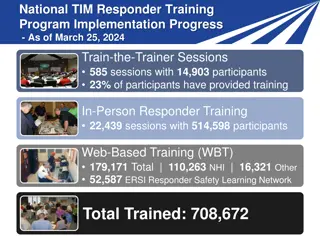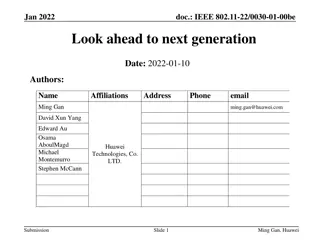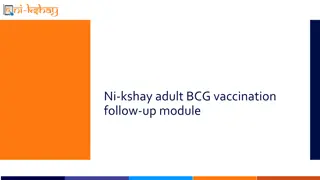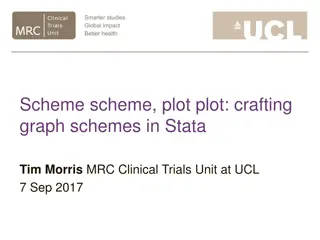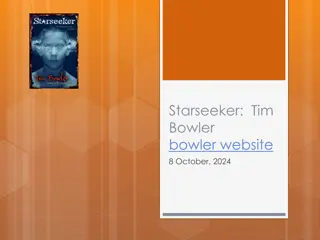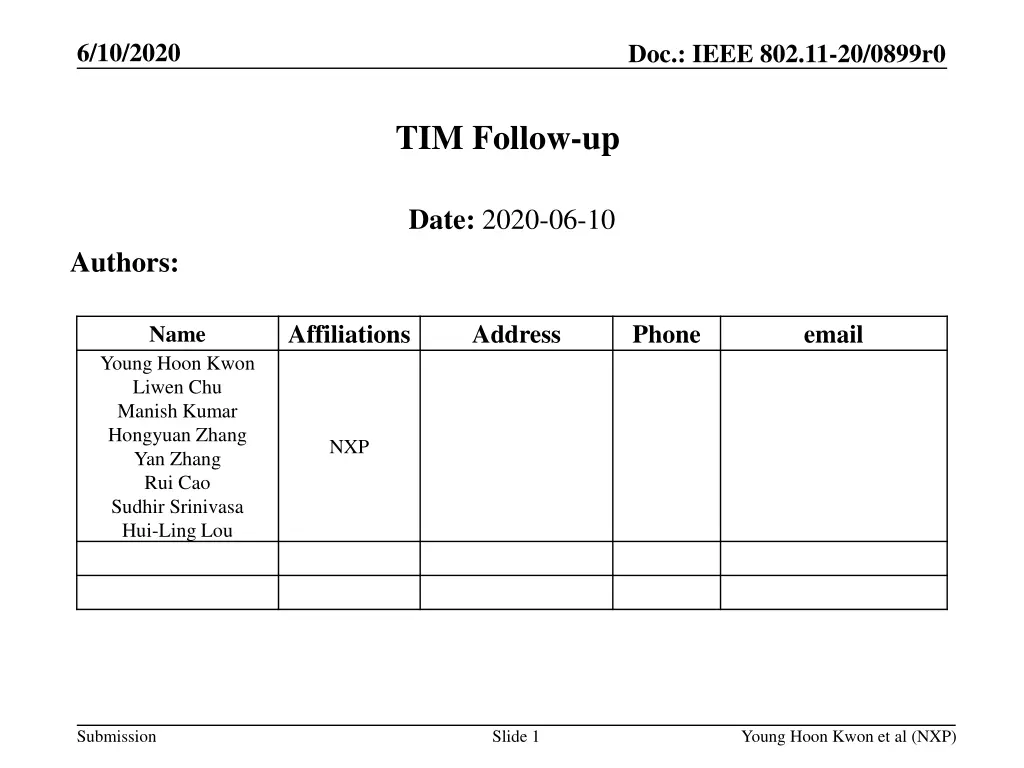
Understanding TIM Indication in IEEE 802.11-20 Standard
Explore the details of TIM indication in IEEE 802.11-20/0899r0, focusing on the agreements, operational parameters, and implications for per-link based parameters. Dive into the baseline U-APSD operation, QoS Capability element format, and U-APSD operation issues related to TIM indication for STAs. Discover how different parameters affect TIM indication in this detailed discussion.
Download Presentation

Please find below an Image/Link to download the presentation.
The content on the website is provided AS IS for your information and personal use only. It may not be sold, licensed, or shared on other websites without obtaining consent from the author. If you encounter any issues during the download, it is possible that the publisher has removed the file from their server.
You are allowed to download the files provided on this website for personal or commercial use, subject to the condition that they are used lawfully. All files are the property of their respective owners.
The content on the website is provided AS IS for your information and personal use only. It may not be sold, licensed, or shared on other websites without obtaining consent from the author.
E N D
Presentation Transcript
6/10/2020 Doc.: IEEE 802.11-20/0899r0 TIM Follow-up Date: 2020-06-10 Authors: Affiliations Address Phone email Name Young Hoon Kwon Liwen Chu Manish Kumar Hongyuan Zhang Yan Zhang Rui Cao Sudhir Srinivasa Hui-Ling Lou NXP Submission Slide 1 Young Hoon Kwon et al (NXP)
6/10/2020 Doc.: IEEE 802.11-20/0899r0 Recap: Current agreement of TIM indication: A bit in a partial virtual bitmap of a TIM element that corresponds to a non-AP MLD is set to 1 if any individually addressed BUs for the non-AP MLD are buffered by the AP MLD. When a non-AP MLD made a multi-link setup with an AP MLD, one AID is assigned to the non-AP MLD across all links. These agreements imply that TIM indication is per-MLD operation. However, other operational parameters are presumably per-link based. Each STA of an MLD may independently select and manage its operational parameters unless specified otherwise in the 11be standard. In this contribution, we discuss how other per-link based parameters affect the TIM indication. Submission Slide 2 Young Hoon Kwon et al (NXP)
6/10/2020 Doc.: IEEE 802.11-20/0899r0 Recap: TIM indication for baseline U-APSD operation At every beacon interval, the APSD-capable AP shall assemble the partial virtual bitmap containing the buffer status of nondelivery- enabled ACs (if there exists at least one nondelivery-enabled AC) per destination for STAs in PS mode and shall send this out in the TIM element of the Beacon frame. When all ACs are delivery-enabled, the APSD-capable AP shall assemble the partial virtual bitmap containing the buffer status for all ACs per destination. When the STA detects that the bit corresponding to its AID is 1 in the TIM, the STA shall issue a PS-Poll frame, or a trigger frame if the STA is using U-APSD and all ACs are delivery-enabled, to retrieve the buffered BU. At each unscheduled SP for a STA, the AP shall attempt to transmit at least one BU, but no more than the value specified in the Max SP Length field in the QoS Capability element from delivery-enabled ACs, that are destined for the STA. Submission Slide 3 Young Hoon Kwon et al (NXP)
6/10/2020 Doc.: IEEE 802.11-20/0899r0 Recap: Baseline QoS Capability element: Format of QoS Info field, when sent by a non-AP STA: Each of the ACs U-APSD Flag subfields is 1 bit in length and set to 1 in (Re)Association Request frames to indicate that the corresponding AC (AC_BE, AC_BK, AC_VI, or AC_VO) is both trigger-enabled and delivery- enabled. It is set to 0 in (Re)Association Request frames to indicate that the corresponding AC is neither trigger-enabled nor delivery-enabled. Submission Slide 4 Young Hoon Kwon et al (NXP)
6/10/2020 Doc.: IEEE 802.11-20/0899r0 U-APSD operation Issues TIM indication for a STA corresponds to Nondelivery-enabled ACs if there exists at least one nondelivery- enabled AC Delivery-enabled ACs if all ACs are delivery-enabled Number of BUs to be delivered in a unscheduled SP is limited up to Max SP Length information. U-APSD related parameters are declared in QoS Capability element of the STA s (Re)Association Request frame. If a non-AP MLD has different QoS capability on different link, it is not clear which ACs a TIM indication corresponds to: For example, if an AC is declared as nondelivery-enabled AC on link 1 but is declared as delivery-enabled AC on link 2, and if an AP MLD has a buffered BU of the AC, does the AP MLD need to set the TIM bit for the non-AP MLD to 1 or 0? Submission Slide 5 Young Hoon Kwon et al (NXP)
6/10/2020 Doc.: IEEE 802.11-20/0899r0 U-APSD operation Option 1 A non-AP MLD shall have the same U-APSD Flag for each AC across all links that multi-link is setup. As both TIM indication and U-APSD Flag for each AC are per- MLD level, there s no ambiguity of indicating TIM bit to a non-AP MLD. Submission Slide 6 Young Hoon Kwon et al (NXP)
6/10/2020 Doc.: IEEE 802.11-20/0899r0 U-APSD operation Option 2 Allows a non-AP MLD to have different U-APSD Flag for each AC on different link. TIM bit for the non-AP MLD is set to 1 if conditions for setting the TIM bit to 1 on any link for the non-AP MLD are satisfied. We prefer Option 1 U-APSD Flags are traffic QoS related parameters that doesn t need to be considered as per-link parameters. Submission Slide 7 Young Hoon Kwon et al (NXP)
6/10/2020 Doc.: IEEE 802.11-20/0899r0 Listen Interval/WNM Sleep Interval The Listen Interval field is used to indicate to the AP how often a non-S1G STA in power save mode wakes to listen to Beacon frames. Also, the WNM Sleep Interval field indicates to the AP how often a STA in WNM sleep mode wakes to receive Beacon frames, defined as the number of DTIM intervals. STAs in WNM sleep mode can wake up as infrequently as once every WNM sleep interval to check whether the corresponding TIM bit is set or group addressed traffic is pending. However, for a non-AP MLD that multi-link is setup with an AP MLD, as the non-AP MLD s PS-Poll/Trigger frame transmission can happen on any of setup links, it is possible that the non-AP MLD triggers the buffered BU transmission on other links before the listen interval on a link expires. Submission Slide 8 Young Hoon Kwon et al (NXP)
6/10/2020 Doc.: IEEE 802.11-20/0899r0 Listen Interval/WNM Sleep Interval We propose: Listen interval and WNM sleep interval of a non-AP MLD is applied at the MLD level and not at the STA level. When the non-AP MLD is in power save mode on one or more links, the non-AP MLD listens to Beacon frames of an AP MLD on any link that indicates the buffered BU information of the one or more links at least once in the listen interval value. When the non-AP MLD is in WNM sleep mode on one or more links, the non-AP MLD listens to Beacon frames of an AP MLD on any link that indicates the buffered BU information of the one or more links at least once in the WNM sleep interval value. Submission Slide 9 Young Hoon Kwon et al (NXP)
6/10/2020 Doc.: IEEE 802.11-20/0899r0 Listen Interval/WNM Sleep Interval Signaling methods for Listen Interval: Listen Interval field is included in a (Re)Association Request frame from a non-AP MLD. Several methods can achieve MLD level listen interval value Having Listen Interval field to be MLD (common) information. Having Listen Interval field to be per-link indication, and the Listen Interval field of different link to be set to the same value. Having Listen Interval field to be per-link indication, and the listen interval value is a function of the Listen Interval field values of different links, such as maximum of the Listen Interval field value among all links, etc. Submission Slide 10 Young Hoon Kwon et al (NXP)
6/10/2020 Doc.: IEEE 802.11-20/0899r0 Summary As a partial virtual bitmap of a TIM element is per- MLD indication, we propose to have several related features to be per-MLD indication. U-APSD Flags Listen interval WNM sleep interval Submission Slide 11 Young Hoon Kwon et al (NXP)
6/10/2020 Doc.: IEEE 802.11-20/0899r0 SP1 Do you agree to add the following to 11be SFD: A non-AP MLD shall have the same U-APSD Flag value for each AC across all links that multi-link is setup. Submission Slide 12 Young Hoon Kwon et al (NXP)
6/10/2020 Doc.: IEEE 802.11-20/0899r0 SP2 Do you agree to add the following to 11be SFD: Listen interval and WNM sleep interval of a non-AP MLD is applied at the MLD level and not at the STA level. Submission Slide 13 Young Hoon Kwon et al (NXP)

